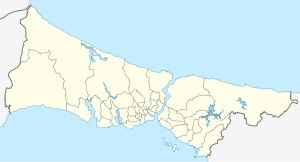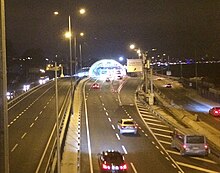Eurasia tunnel
| Avrasya Tüp Tüneli | ||
|---|---|---|
| use | Road tunnel | |
| place |
Istanbul , Turkey |
|
| length | 5400 m | |
| Number of tubes | 1 (two-story use) | |
| cross-section | 452.39 m² | |
| construction | ||
| Client | Ministry of Transport, Maritime Affairs and Communications | |
| start of building | February 26, 2011 | |
| completion | 2016 | |
| planner | YMSK (Yapı Merkezi Turkey , SK Engineering & Construction South Korea )
|
|
| business | ||
| toll | Yes | |
| release | 20th December 2016 | |
| location | ||
|
|
||
| Coordinates | ||
| west | 41 ° 0 ′ 9 ″ N , 28 ° 58 ′ 11 ″ E | |
| east | 41 ° 0 ′ 21 " N , 29 ° 1 ′ 34" E | |
The Eurasia Tunnel ( Turkish Avrasya Tüp Tüneli ) is a 5.4 kilometer long road tunnel under the Bosphorus in Istanbul . About one kilometer north is the Marmaray railway tunnel . The construction work began on February 26, 2011, the breakthrough took place on August 22, 2015. On December 20, 2016 it was opened to traffic. The Turkish-South Korean joint venture YMSK (Yapı Merkezi and SK Engineering & Construction) planned and managed the work.
location
It is the first road tunnel to connect the western part of Europe ( Fatih district ) with the eastern part of Asia ( Üsküdar ) of the Turkish metropolis of Istanbul. In the west, it connects to Kennedy Caddesi , which, as a central traffic axis, connects Istanbul's old town with Istanbul Ataturk Airport . In the east, the tunnel ends at Harem İskele Caddesi, which merges into the D 100 expressway and ultimately into the highways to Bursa and Ankara . As part of the project, the access roads between Kazlıçeşme and Göztepe were also expanded in order to cope with the increased volume of traffic. The Eurasia Tunnel is thus intended to shorten the travel time across the Bosporus between the two endpoints from 100 to 110 minutes over the Bosporus bridges to around 15 minutes.
construction
The Eurasia Tunnel is a two-story tunnel with two lanes each. The tunnel was driven with a clear width of 13.7 meters and has a usable diameter of 12 meters. At its deepest point, it reaches 106.4 meters below sea level , with the tunnel ceiling remaining about 25 meters below the rock. This should ensure earthquake security up to a magnitude of 7.5 on the Richter scale . Two hydraulic compensation rings should give the tunnel a flexibility of up to 7 cm in all directions against earthquakes. The tunnel entrance on the European side was raised above sea level to protect this entrance from possible tsunamis .
The German company Herrenknecht AG was commissioned to build the tunnel . High technical requirements had to be met: A very high proportion of sand and other loose rock required a specially made tunnel boring machine (TBM) with Mixshield technology that could pierce both hard rock and soft sand without getting stuck. Above all, however, the tunnel tubes here also have to compensate for the highest water pressure in the history of technology of up to 11 bar .
Environmental influences and archaeological aspects were also taken into account during construction.
business
The tunnel is only approved for cars and minibuses. In addition to rescue systems and four turning points, uninterrupted availability of light, air, telephone and internet are provided in the tunnel. Navigation devices used in road traffic and shipping will remain unaffected, as will telemetry systems . A traffic volume of 80,000 to 120,000 vehicles is expected daily. A toll fee of 16.60 Turkish Lira (about 1.89 €) per car and 24.90 TL (about 2.84 €) for minibuses is charged for each passage . The fees are intended to amortize the construction costs and ongoing operating costs within 25 years .
The cost was the equivalent of 1.19 billion euros. An international bank consortium financed the construction loan for the Turkish state, including the European Investment Bank , European Bank for Reconstruction and Development (EBRD), Korean Exim Bank, Korean Export Insurance Agency (K Sure), Standard Chartered Bank , Sumitomo Mitsui Banking Corporation and three other Turkish banks.
Web links
- Avrasya Tüneli / Eurasia Tunnel. Operating company of the Eurasia Tunnel (Turkish, English).
- Connecting Continents. In: All Around. Herrenknecht AG . No. 4, large-format photos of the tunnel construction (German).
- Eurasia Tunnel Project. ( Memento from January 20, 2016 in the Internet Archive ). In: Unicredit - Yapı Merkezi, SK EC Joint Venture. 2012 (English; PDF; 29 p., 4.97 MB).
Individual evidence
- ↑ a b Istanbul: drilling of the Eurasia tunnel completed. ( Memento from April 1, 2016 in the Internet Archive ). In: German-Turkish newspaper. 23rd August 2015.
- ^ Road under the Bosporus: Eurasia tunnel opened in Istanbul. In: ORF News. December 20, 2016, accessed December 20, 2016.
- ↑ a b Özgür Altuncu, Ünsal Çakın (DHA): Başbakan Erdoğan, 'Yıldırım Bayezid'le Avrasya Tüneli'ni kazmaya başladı. In: Radical . April 19, 2014 (Turkish), press report with a map of the transport route, accessed on December 20, 2016.
- ↑ a b Eurasia Tunnel: Erdoğan makes the first trip. In: Daily Sabah . October 9, 2016 (German), press report on the first ascent and cross-sectional drawing, accessed on December 20, 2016.
- ↑ a b c Fatih Özdemir: Avrasya Tüneli ile Boğaz'ın altında arabalı yolculuk! In: fozdemir.com. August 24, 2012 (Turkish), accessed December 20, 2016.
- ↑ a b Eurasia Tunnel Project - Technical - Seismic Provisions. ( Memento from January 20, 2016 in the Internet Archive ). In: Unicredit - Yapı Merkezi, SK EC Joint Venture. 2012 (PDF; 29 p., 4.97 MB), p. 18.
- ↑ High tech under the Bosporus. Ultimate tunnel advance. In: All Around. (Herrenknecht) No. 4, 2016, accessed on March 5, 2017.
- ↑ Press release: Istanbul. A giant dives deep and brings Europe and Asia together on the Bosporus. In: Herrenknecht AG . August 28, 2015, accessed March 5, 2017.
- ↑ Connecting Continents. In: All Around. (Herrenknecht) No. 4, 2016.
- ^ Environmental and Social Impact Assessment for the Eurasia Tunnel Project. In: ERM Group, Germany and UK / ELC-Group, Istanbul. January 2011 (English), (PDF; 46 p., 894.6 kB).
- ↑ a b abl / dpa / AFP : Turkey opens the first road tunnel between Europe and Asia. In: SpOn . 20th December 2016.
- ↑ tolls. In: Avrasya Tüneli / Eurasia Tunnel. (English).
- ^ Eurasia Tunnel Project. ( Memento from January 20, 2016 in the Internet Archive ). In: Unicredit - Yapı Merkezi, SK EC Joint Venture. 2012 (English), p. 25 (PDF; 29 p., 4.97 MB).


